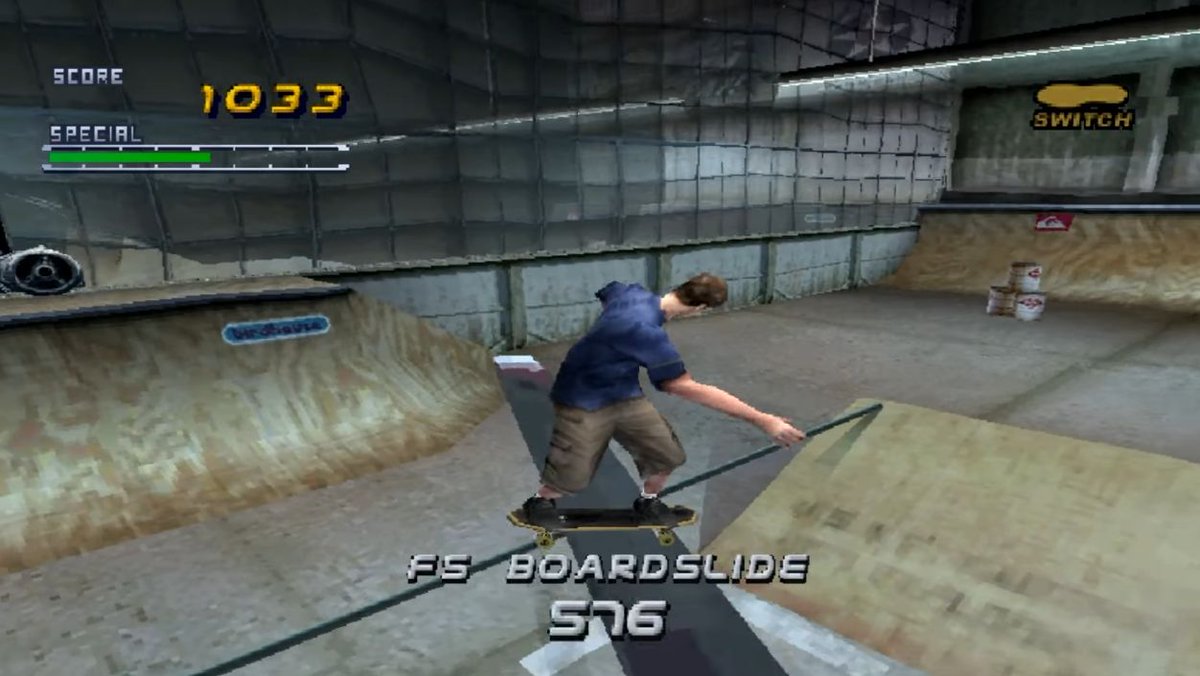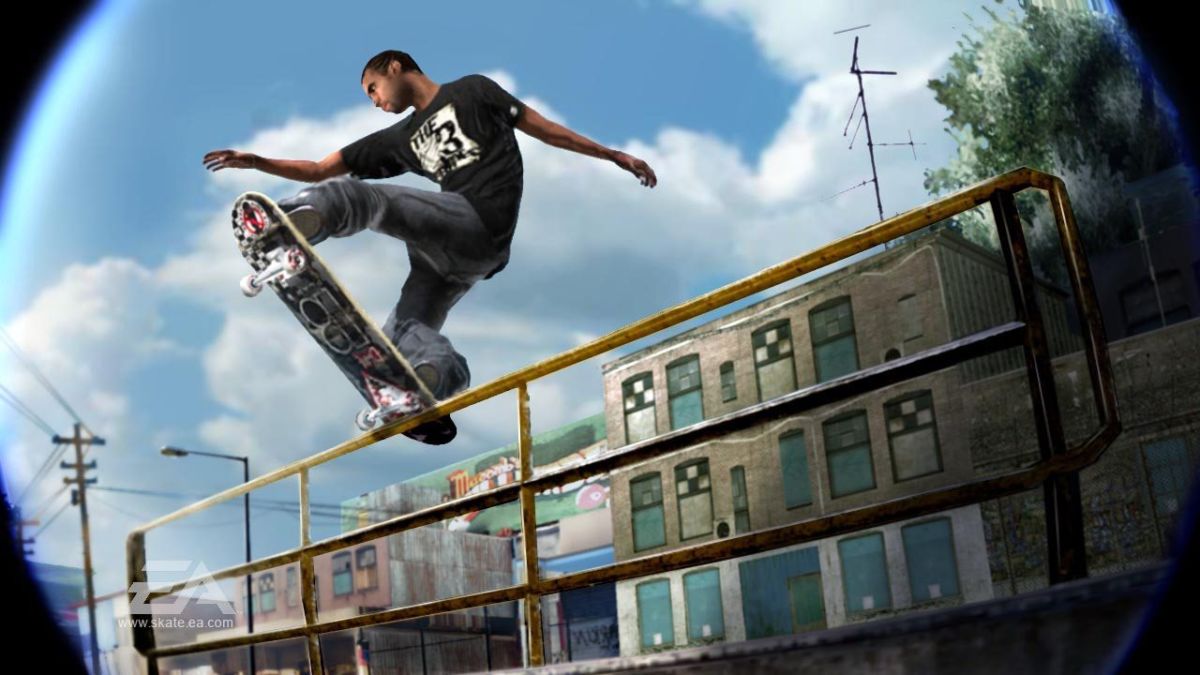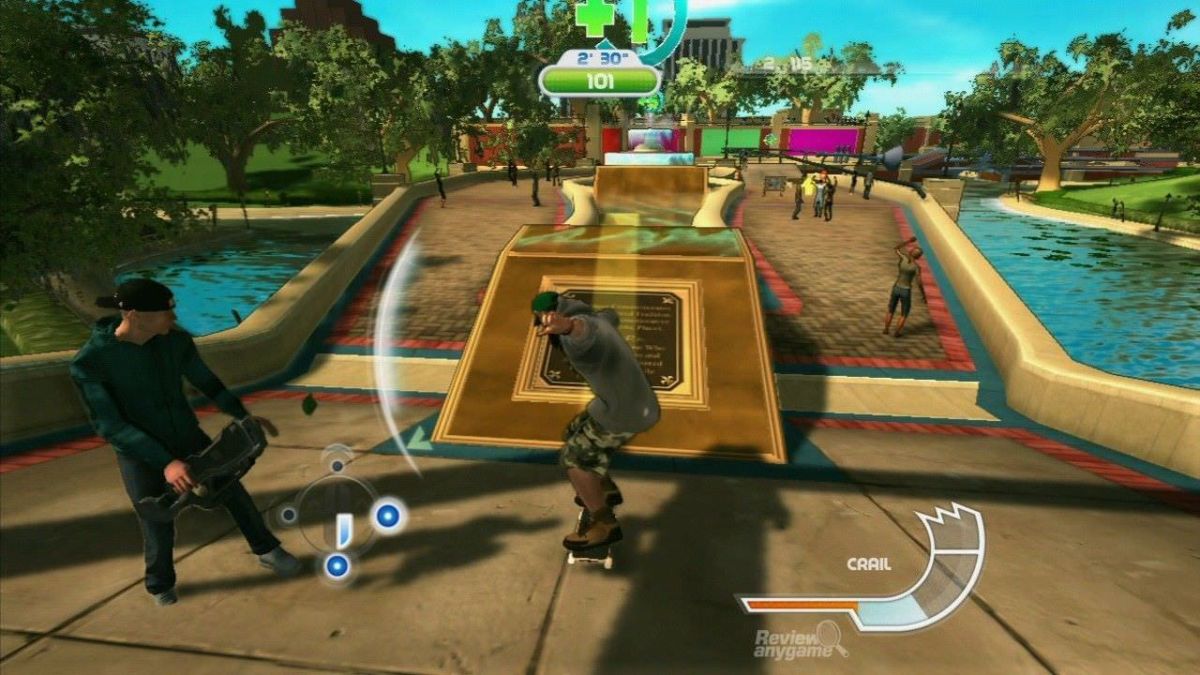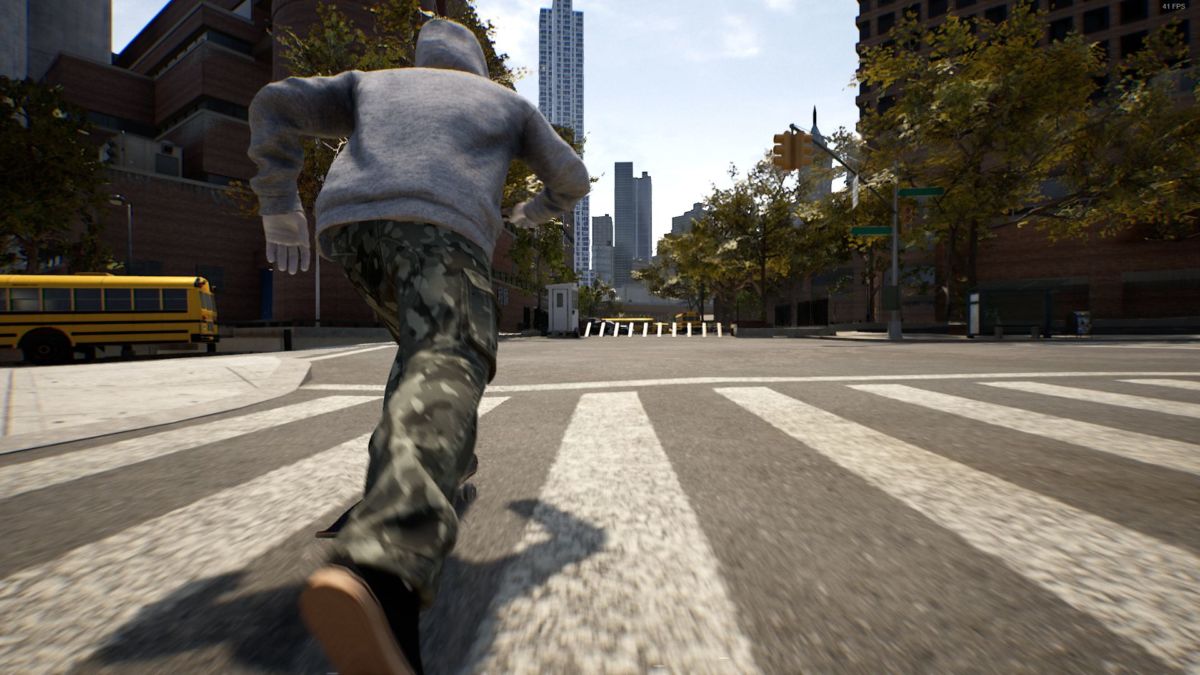Ever since a handful of L.A. surfers slapped wheels onto some boards and started carving empty backyard pools, skateboarding became synonymous with the freedom of youth and the rebelliousness that freedom entails. Before long, the extreme sport became ingrained into our culture, spreading from its SoCal roots through the country and eventually the world, even becoming an Olympic sport in 2020.
It should come as no surprise then that by the mid-80s it had fully infiltrated our video games, evolving over time to be one of the most profitable ventures in the industry before wiping out in 2010, then rising like a phoenix once more through the help of modern indie development. Don’t forget to bend your knees because we’re gonna be rolling fast through the saga of the world’s most popular extreme sport.
Birth (1986-1998)

The earliest signs of skateboarding in video games can be traced back to Atari’s 720°, released to the arcades in 1986. Despite being the first game to feature the sport, it would go on to define what the genre would become with a score-centric combo system, collectibles scattered throughout each level, and a timer tied to every run. Activision would make their first fateful step into the ring a year later (1987) with Skate Boardin’ for the Atari 2600, designed by none other than David Crane, the creator of Pitfall.
But when EA dropped Skate or Die the same year for the ZX Spectrum, among other home computers, as well as a Konami published “Ultra Games” NES port, Skate Boardin’ seemed downright primitive. On top of the graphics, Skate or Die had the edge when it came to broad availability, gameplay, and the sneering punk rock edge that the entire sport has since been known for. Whether you were racing down hazardous hillsides, interacting with the memorable NPCs, or simply spending hours on the game’s full sized halfpipe, EA proved to have an early hit well ahead of Activision’s instantly dated 2600 outing.
While these early examples of the genre aren’t much to look at today, clearly discernible facets such as ramps, rails, attitude, and half-pipes proved that the high-speeds high-octane lifestyle associated with skateboarding was a universal thrill that even those who would never mount a four-wheeled plank of their own could understand and enjoy.
See also: California Games, Skate or Die 2, Back to the Future (NES, 1989)
Hitting Its Stride (1999-2002)

It can be argued that Tony Hawk is better known (if he’s known at all) for his video games rather than his 35+ year running tenure as a professional skateboarder, but in July of 1999 when he landed the first ever 900° at the X-Games, he made skateboarding history. Conversely, three months later in September, he made video game history with the release of the first ever Tony Hawk’s Pro Skater (THPS) for the PlayStation, his legendary moment in tow.
Neversoft’s initial foray into the genre might have been immediately met with competition and imitation in the form of Thrasher: Skate and Destroy the same month or Razor: Freestyle Scooter the next year, but there was no denying that THPS’ mixture of punk attitude and easy-to-learn-difficult-to-master arcade gameplay reigned supreme as the game surpassed its contemporaries and quickly became a global phenomenon.
Throwing skateboarding into the limelight and introducing a generation of children and teens to the addictive cultural and musical stylings of The Vandals, Dead Kennedys and of course Goldfinger was nothing to be taken lightly. Neversoft and Activision captured the minds of gamers everywhere and they knew it, capitalizing on THPS’ success with a flurry of annual sequels over the remainder of the PlayStation’s lifecycle.
Pro Skater 2 refined the gameplay with some of the best levels in the series and the addition of the much needed manual mechanic to make comboing flatground possible. Pro Skater 3 pushed the engine further with deeper character customization and a revert system, now making transition skateboarding a viable full-combo method, throwing high scores into the millions, while Pro Skater 4 capped the generation off with a mission-based open world structure and the removal of the 2 minute time limit, which are changes that would define the series going forward.
The demand for the genre became a fever and the only cure was more skateboarding. A surge of new skaters picked up boards, games like Spyro 3 threw the dragon on a board for kicks, and Tony Hawk became a name recognized all over the world. Such wild success led to an even broader array of inevitable Pro Skater imitators, including but not limited to: Evolution Skateboarding by Konami, Aggressive Inline and BMX XXX from Acclaim, and even The Simpsons Skateboarding published by Fox Interactive and EA (who we’ll get to later, mark my words). None could hold a candle to the Birdman’s empire.
See also: Jet Set Radio, 2Xrteme, Metal Gear Solid 2’s Evolution Skateboarding Demo
Rise and Fall (2003-2007)

Showing no signs of slowing down, the Tony Hawk franchise reached its generally agreed on peak with the release of 2003’s Tony Hawk’s Underground (THUG). Despite Activision’s (now all too familiar) yearly release requirement for the IP, Neversoft managed to drastically evolve the series from a formulaic arcade skateboarding game to a story-driven adventure game based around the misadventures of neighborhood skaters.
It was crude, over the top, and a departure from the short bursts of arcade action that made the series so beloved, but the gamble paid off and THUG went on to be one of the best-selling games at the time on each respective console it launched for. THUG then received its inevitable sequels, including a Disney-themed spin-off and a massive Jackass crossover in the form of THUG 2. But everything changed in 2007 when EA launched the first entry of Black Box’s innovative Skate series.
Using the modern innovation known as analog sticks, Skate expected the player to control their actions like never before, flicking the right stick to do flips, spinning it to shove-it, and using the triggers for variable grabs with each hand. Include a masterful implementation of the best physics engine of the era and suddenly video game skateboarding felt like real skateboarding. If you missed a trick, you fell hard and bled. If your board went upside down, bailing out was the only way to avoid eating the pavement. It was gritty and offered an alternative that consumers weren’t anticipating.
Skate came out of nowhere and solved a problem with skateboarding games that nobody knew existed: a lack of realistic representation for the sport. Where the Tony Hawk series escalated in zany antics and input-based combo systems, Skate forced you to take 1000 steps back and simply learn what was required of a skateboarder to pull off something as simple as a kickflip. The new analog stick-based system changed everything and, suddenly, the Tony Hawk franchise felt as aged and archaic as its namesake.
See also: Tony Hawk’s American Wasteland, Tony Hawk’s Downhill Jam, Tony Hawk’s Underground 2
Fatigue & Death (2008-2010)

Once there were two big players on the skateboarding game market, consumers were understandably split. Despite the Tony Hawk series continuing to sell well enough to continue, the shockwaves caused by Skate didn’t go unnoticed, least of all by Activision. Following a hamfisted mimickry of Skate’s (then only announced) stick-based trick system and gritty aesthetic in the form of Tony Hawk’s Project 8’s less-than-innovative “Nail-the-Trick” mechanic, and the otherwise serviceable, but underperforming Tony Hawk’s Proving Grounds, Activision dumped long-time developer Neversoft and turned to the harbinger of death for the series: Robomodo.
While EA comfortably continued building its own niche fanbase through the release of the well-received Skate 2, by the end of 2009 Activision were clearly playing defense in fear of losing sales. Yet that’s exactly what they did when they shipped Tony Hawk: Ride and its infamous skateboard peripheral. You can just imagine some suit at Activision slamming a desk as he declares “Skate is more realistic eh? Well you can’t get more realistic than an actual board can you?!” And despite Tony’s best efforts to sell this next evolution of his beloved franchise, the game was universally panned and performed worse commercially than any main entry in the series to date.
With all the annual releases from Activision, EA’s niche but up-and-coming Skate series, and a sea of other annual releases, it should come as no surprise that oversaturation led to the death of skateboarding video games. In 2010, EA released Skate 3 as the final revision to its masterful contribution to the genre, while Activision released an ill-advised sequel to Ride called Shred that featured worse visuals, snowboarding for some reason, and yet another heavy, non-responsive plastic skateboard. And like throwing dirt on the coffin, Shaun White released his own half-baked skateboarding game the same year, because why not? Skateboarding in video games had officially died.
Aside from Activision’s obvious nostalgia cash grab with the release of Tony Hawk’s Pro Skater HD, Robomodo’s bastardized representation of the first two games, the genre laid dormant until 2014 when a little indie game called OlliOlli shredded its way into gamers’ Steam libraries and reinvented skateboarding in video games once again.
See also: Shaun White Snowboarding, Tony Hawk’s Motion, Tony Hawk’s Shred Session
Revival & Future (2014-Hopefully the End of Time)

Combining the retro aesthetic of the genre’s humble 8-bit Skate or Die beginnings with modern features like combo stringing and analog direction-based Skate-esque tricking, OlliOlli struck a nostalgic chord with gamers worldwide as we all came together around the wonderful sport of skateboarding again. There’s no way it’s a coincidence then, that in the same year of OlliOlli’s release, Skate 3 went into sudden high demand (with a little help from PewDiePie, sure). Interest in the game was so high that EA had to start reprinting the then 4-year-old last gen game. Skateboarding was once again on the rise.
As if reacting to a gunshot, Activision hastily responded with one final nostalgic Robomodo cash-grab with 2015’s Tony Hawk’s Pro Skater 5. Despite the name implying a return to the series’ roots, THPS5 ensured that everything that could be ruined would be ruined. Soulless environments, boring goals, poorly hidden collectibles, and ugly graphics were the least of the game’s worries, as it boasted bugs galore, Lil’ Wayne for some reason, and the worst offense of all, a completely unengaging soundtrack consisting of Christian Rock, anti-Pop, and even a Skrilllex track (who even by 2015 had run his course with the masses).
Now even though shitting on THPS5 is a fun time (arguably more fun than the game itself), rather than kill interest in the genre once again, its universally awful quality spurred consumer demand for a good skateboarding game to higher heights. OlliOlli 2: Welcome to Olliwood launched to immediate success, EA probably gets at least a dozen e-mails every day from fans requesting a Skate 4, and even more independent developers have unveiled their future projects related to the sport.
Perfect Stride seeks to combine the movement tech of FPS games with the physics of a skateboard. Session, while still in Early Access, smashed its Kickstarter campaign in a mere 3 days in hopes to satiate the cries for Skate 4 with its own realistic skateboarding sim. Skater XL is also in Early Access, and has been there for quite a while, but with an emphasis on real world skate spots and perfecting the controls, it’s another promising sign of what’s to come. And then Skatebird throws everything out the window and just lets you play as a little skateboarding bird in skateparks made of bendy straws and curled magazines.
See also: THUG Pro, True Skate
Thanks to the Tony Hawk franchise, one of the best genres of sports video games reached gamers worldwide. Thanks to the Tony Hawk franchise, that genre died a sudden death. And now thanks to the worst game in the Tony Hawk franchise, the future of skateboarding in video games is looking bright. Please don’t screw it up, or I might actually have to learn how to skate.
MORE GAMING:
– 35 Best PS4 Exclusive Games You Should Play
– 25 Best Xbox One Online Multiplayer Games
– 20 Best PS4 FPS Games You Should Play
Some of the coverage you find on Cultured Vultures contains affiliate links, which provide us with small commissions based on purchases made from visiting our site.

